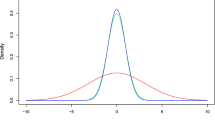Abstract
This paper considers spectral and autocovariance estimation for a zero-mean, band-limited, stationary process that has been sampled at time points jittered from a regular, equi-interval, sampling scheme. The case of interest is where the sampling scheme is near regular so that the jitter standard deviation is small compared to the sampling interval. Such situations occur with many time series collected in the physical sciences including, in particular, oceanographic profiles.
Spectral estimation procedures are developed for the case of independent jitter and autocovariance estimation procedures for both independent and dependent jitter. These are typically modifications of general estimation procedures proposed elsewhere, but tailored to the particular jittered sampling scheme considered. The theoretical properties of these estimators are developed and their relative efficiencies compared.
The properties of the jittered sampling point process are also developed. These lead to a better understanding, in this situation, of more general techniques available for processes sampled by stationary point processes.
Similar content being viewed by others
References
Akaike, H. (1960). The effect of timing error on the power spectrum of sampled data, Ann. Inst. Statist. Math., 11, 145–165.
Akaike, H. and Ishiguro, M. (1980). Trend estimation with missing observations, Ann. Inst. Statist. Math., 32, 481–488.
Balakrishnan, A. V. (1962). On the problem of time jitter in sampling, Institute of Radio Engineers Transactions on Information Theory, 8, 226–236.
Brillinger, D. R. (1972). The spectral analysis of stationary interval functions, Proceedings of the 6th Berkeley Symposium on Mathematical Statistics and Probability (ed. L.LeCam, J.Neyman and E. L.Scott), 483–513, University of California Press, Berkeley.
Brillinger, D. R. (1983). Statistical inference for irregularly observed processes, Time Series Analysis of Irregularly Observed Data, Lecture Notes in Statist., 25, 38–57, Springer, New York.
Cox, D. R. and Lewis, P. A. W. (1966). The Statistical Analysis of Series of Events, Methuen, London.
Daley, D. J. and Vere-Jones, D. (1988). An Introduction to the Theory of Point Processes, Springer, New York
Ibragimov, I. A. and Rozanov, Y. A. (1978). Gaussian Random Processes, Springer, New York.
Jones, R. H. (1971). Spectrum estimation with missing observations, Ann. Inst. Statist. Math., 23, 387–398.
Lawrance, A. J. (1972). Some models for stationary series of univariate events, Stochastic Point Processes (ed. P. A. W.Lewis), 199–255, Wiley, New York.
Lewis, T. (1961). The intervals between regular events displaced in time by independent random deviations of large dispersion, J. Roy. Statist. Soc. Ser. B, 23, 476–483.
Lii, K.-S. and Masry, E. (1992). Model fitting for continuous-time stationary processes from discrete-time data, J. Multivariate Anal., 41, 56–79.
Masry, E. (1978). Alias-free sampling: an alternative conceptualization and its applications, IEEE Trans. Inform. Theory, 24, 317–324.
Masry, E. (1983a). Non-parametric covariance estimation from irregularly-spaced data, Advances in Applied Probability Theory, 15, 113–132.
Masry, E. (1983b). Spectral and probability density estimation from irregularly observed data, Time Series Analysis of Irregularly Observed Data, Lecture Notes in Statist., 25, 225–250, Springer, New York.
Moore, M. I. and Thomson, P. J. (1991). Impact of jittered sampling on conventional spectral estimates, Journal of Geophysical Research, 96, 1.519–18.526.
Moore, M. I., Visser, A. W. and Shirtcliffe, T. G. L. (1987). Experiences with the Brillinger spectral estimator applied to simulated irregularly observed processes, J. Time Ser. Anal., 8, 433–442.
Moore, M. I., Thomson, P. J. and Shirtcliffe, T. G. L. (1988). Spectral analysis of ocean profiles from unequally spaced data, Journal of Geophysical Research, 93, 655–664.
Moran, P. A. P. (1950). Numerical integration by systematic sampling, Proceedings of the Cambridge Philosophical Society, 46, 111–115.
Parzen, E. (1957). On consistent estimates of the spectrum of a stationary time series, Ann. Math. Statist., 28, 329–348.
Parzen, E. (ed.) (1983). Time Series Analysis of Irregularly Observed Data, Lecture Notes in Statist., 25, Springer, New York.
Robinson, P. M. (1980). Continuous model fitting from discrete data, Directions in Time Series (ed. D. R.Brillinger and G. C.Tiao), 263–278, Institute of Mathematical Statistics, California.
Robinson, P. M. (1984). Kernel estimation and interpolation for time series containing missing observations, Ann. Inst. Statist. Math., 36, 403–417.
Author information
Authors and Affiliations
About this article
Cite this article
Thomson, P.J., Robinson, P.M. Estimation of second-order properties from jittered time series. Ann Inst Stat Math 48, 29–48 (1996). https://doi.org/10.1007/BF00049287
Received:
Revised:
Issue Date:
DOI: https://doi.org/10.1007/BF00049287




